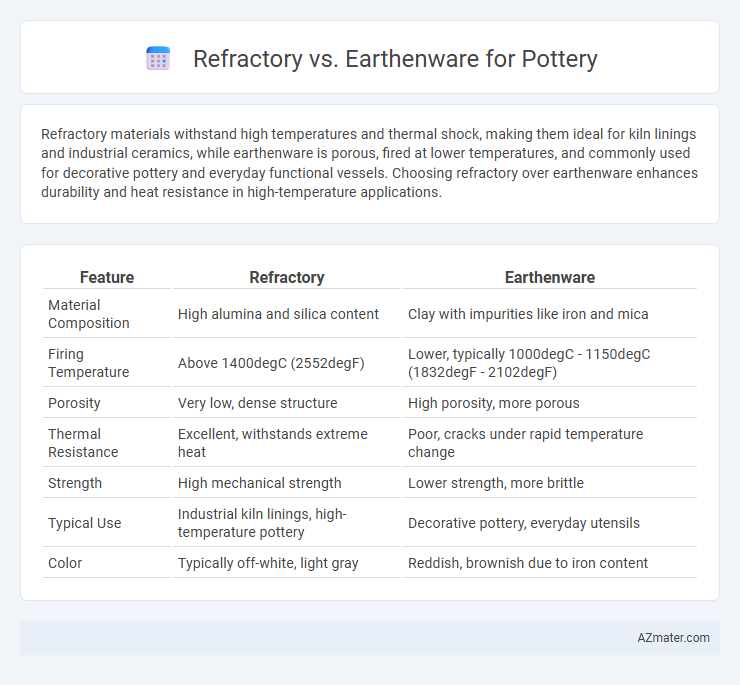Refractory materials withstand high temperatures and thermal shock, making them ideal for kiln linings and industrial ceramics, while earthenware is porous, fired at lower temperatures, and commonly used for decorative pottery and everyday functional vessels. Choosing refractory over earthenware enhances durability and heat resistance in high-temperature applications.
Table of Comparison
| Feature | Refractory | Earthenware |
|---|---|---|
| Material Composition | High alumina and silica content | Clay with impurities like iron and mica |
| Firing Temperature | Above 1400degC (2552degF) | Lower, typically 1000degC - 1150degC (1832degF - 2102degF) |
| Porosity | Very low, dense structure | High porosity, more porous |
| Thermal Resistance | Excellent, withstands extreme heat | Poor, cracks under rapid temperature change |
| Strength | High mechanical strength | Lower strength, more brittle |
| Typical Use | Industrial kiln linings, high-temperature pottery | Decorative pottery, everyday utensils |
| Color | Typically off-white, light gray | Reddish, brownish due to iron content |
Introduction to Pottery Materials
Refractory materials and earthenware represent two distinct categories of pottery clay, each with unique thermal properties and applications. Refractory clays withstand extremely high temperatures without deforming, making them ideal for kiln linings and industrial pottery, while earthenware is a low-fire clay that is porous and less durable, commonly used for decorative or functional pottery pieces. Understanding the differences in firing temperature, durability, and porosity is crucial for selecting the appropriate material in pottery making.
Understanding Refractory Clay
Refractory clay is essential in pottery for its high melting point and resistance to thermal shock, making it ideal for kiln linings and heat-resistant ceramics. Unlike earthenware, which is porous and fired at lower temperatures (approximately 1000-1150degC), refractory clay withstands extreme heat beyond 1500degC without deforming. This durability allows refractory clay to maintain structural integrity during high-temperature firing processes, crucial for advanced ceramic applications.
What Is Earthenware Clay?
Earthenware clay is a porous, low-fire clay body typically fired between 1,000degC to 1,150degC, known for its rich, warm tones and ease of shaping. Unlike refractory clay, which withstands extremely high temperatures used in industrial applications such as kiln linings and furnace bricks, earthenware is suited for decorative pottery, tableware, and sculptures. Its lower firing temperature makes earthenware less durable but more accessible for beginners and versatile for various artistic finishes.
Key Differences Between Refractory and Earthenware
Refractory pottery is designed to withstand high temperatures, making it ideal for kiln linings and industrial applications, whereas earthenware is a porous, low-fired clay often used for decorative and functional ceramics. Refractory materials have high thermal stability and resistance to thermal shock, while earthenware is more fragile and less heat-resistant due to its lower firing temperature, typically between 1,000 and 1,150degC. The chemical composition differs significantly; refractory clays contain high amounts of alumina and silica, enhancing durability and heat endurance, whereas earthenware contains more iron and fluxes, contributing to its characteristic reddish color and softer texture.
Thermal Properties: Heat Resistance Comparison
Refractory pottery materials exhibit superior heat resistance, withstanding temperatures exceeding 1500degC, making them ideal for high-temperature applications like kiln liners and industrial furnaces. Earthenware, on the other hand, typically withstands temperatures up to 1200degC, limiting its use to decorative or low-heat functional items. The intrinsic thermal properties of refractory ceramics, including low thermal expansion and high melting points, provide enhanced durability under extreme heat compared to the more porous and less heat-resistant earthenware.
Workability and Firing Temperatures
Refractory clay offers superior workability for intricate pottery designs due to its plasticity and higher firing tolerance, typically between 1,200degC to 1,400degC, enabling durability and resistance to thermal shock. In contrast, earthenware works best at lower firing temperatures of about 1,000degC to 1,150degC, which results in more porous and less heat-resistant ceramics but allows for easier shaping and faster firing cycles. Choosing between refractory and earthenware depends on the desired balance between workability and the pottery's functional heat endurance.
Durability and Usage in Pottery
Refractory clay is highly durable and capable of withstanding extreme temperatures, making it ideal for kiln furniture, firebrick, and high-heat applications in pottery. Earthenware, while less durable and more porous, is favored for decorative and functional pottery that does not require exposure to intense heat, such as vases and dinnerware. The choice between refractory and earthenware depends on the intended use, with refractory suited for high-temperature environments and earthenware best for everyday, low-temperature pottery.
Best Applications for Refractory Clay
Refractory clay is ideal for high-temperature applications such as kiln furniture, furnace linings, and heat-resistant molds due to its exceptional ability to withstand extreme heat without deforming. Unlike earthenware, which is porous and fired at lower temperatures around 1000-1150degC, refractory clay vitrifies at temperatures above 1400degC, making it suitable for industrial and advanced ceramic uses. Its superior thermal stability and durability ensure long-lasting performance in environments subject to intense thermal cycling.
Ideal Uses for Earthenware Pottery
Earthenware pottery is ideal for decorative items, plant pots, and low-temperature cooking vessels due to its porous nature and lower firing temperature compared to refractory ceramics. Its ability to retain moisture makes it suitable for terracotta planters and traditional cooking pots, while its affordability and ease of shaping appeal to artisans and hobbyists. Unlike refractory ceramics, earthenware is less suited for high-heat applications but excels in everyday use and aesthetic pottery pieces.
Choosing the Right Clay for Your Pottery Project
Refractory clay offers exceptional heat resistance and durability, making it ideal for pottery subjected to high temperatures, such as kiln shelves or fireproof vessels. Earthenware clay, known for its porous and softer nature, is easier to shape and perfect for decorative pieces or low-temperature firing projects. Selecting the right clay depends on your pottery's intended use, firing temperature, and desired finish, ensuring optimal performance and longevity.

Infographic: Refractory vs Earthenware for Pottery
 azmater.com
azmater.com